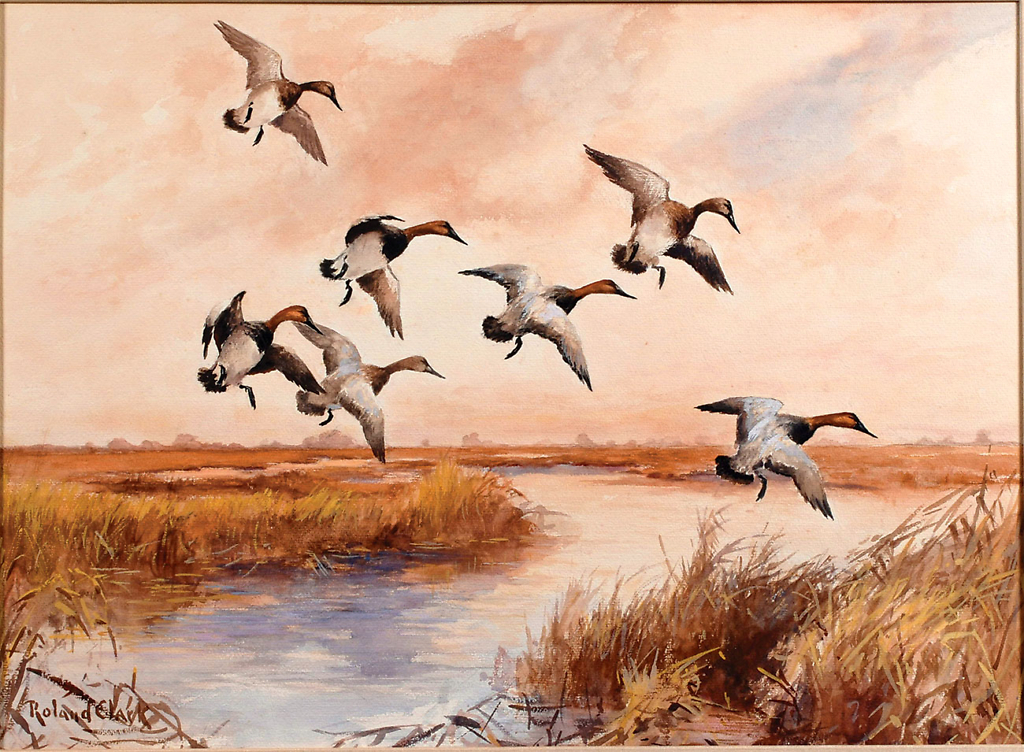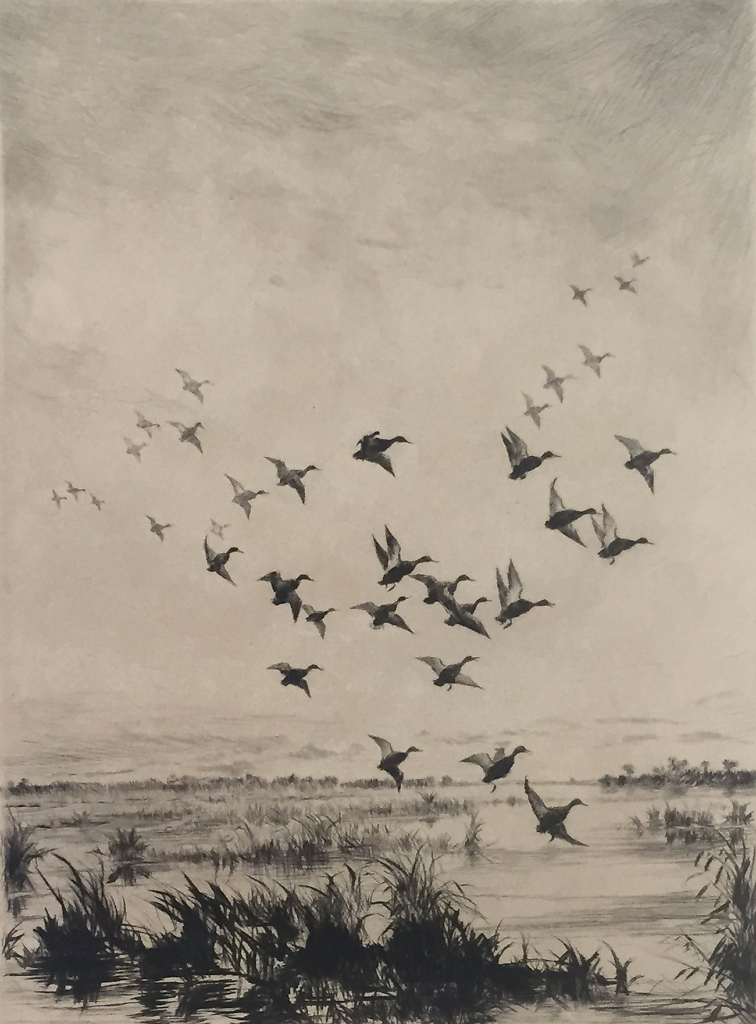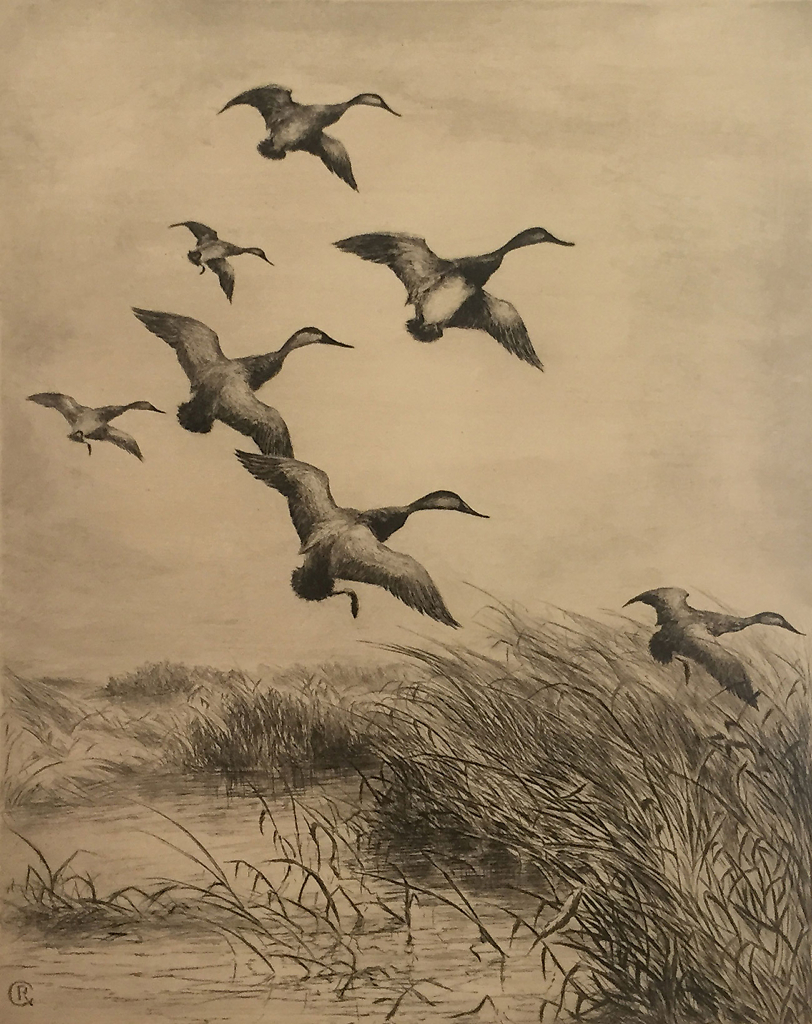
The waterfowl painter, engraver—and author—who merits a Wikipedia page.
[by Brooke Chilvers]
TODAY, THE TRICKLE-DOWN EFFECT of time on the formerly famous boils down to either scoring an entry in the online encyclopedia or fading from public memory, your undigitized books falling out of print and your front-page exploits gradually forgotten. Among the triumvirate of America’s three most renowned waterfowl artists, only one made it across that 21st-century finish line: Paris-educated impressionist Frank W. Benson (1862–1951). Electrical engineer and world traveler Richard E. Bishop (1887–1975), and congenial crack sportsman and raconteur Roland Clark (1874–1957), did not.
Surely Clark deserves his own Wikipedia page. For out of this prolific trio, only he turned his field experiences, from his wild-child boyhood to the imagined tales of the elder gunner’s mind, into highly collectible illustrated books that still stir the hunter’s heart.
Clark’s trajectory, from a kid belly-crawling through autumn-colored marshes with his brother’s sawed-off Civil War musket to one-man shows in Manhattan, evolved from commercial artist to magazine illustrator to oil and watercolor painter to printmaker. He added “artist-author” just as his right-time-at-the-right-place career peaked in the 1930s.
His good luck started with growing up along the Atlantic Flyway in New Rochelle, New York, situated on the Long Island Sound’s northern shore. Although his three brothers graduated from Cornell University in either law or architecture, Clark’s only formal education was at a long-gone NYC private high school. He preferred catboats, punting, and the company of baymen with characters carved by the sea. The innate hunter in him chased the sound’s waterfowl: scaup, mallards, canvasbacks, pintails, redheads, wigeons, shovelers, ringnecks, black ducks, and Canada geese. The incipient artist in him bedecked the family home with drawings of hunters in blinds or sinkboxes aiming their shotguns at migrating wildfowl, boyishly shown exploding and falling from the sky.

BREAK ‘O Day
Apparently Clark demonstrated enough talent to his attorney father to warrant some private tutoring in art and a stint at the Art Students League, which accords no degrees. At the ASL, one instructor’s name is associated with teaching Clark: J. Carroll Beckwith (1852–1917), whose society portraits of lovely ladies in fancy dress, Mark Twain, and Teddy Roosevelt seem not to have influenced Clark’s avifaunal vision.
In 1900, he married Ann Byrd, and they were given five acres to build a home on her father’s elegant White Hall Plantation in Gloucester County, Virginia. Fortuitously set up on Mobjack Bay, a western offshoot of the Chesapeake, Clark dabbled in the oyster business as co-owner of a two-masted schooner. Ungifted in commerce, however, he soon turned full-time to his art, when he wasn’t riding to hounds, breeding and showing his Thoroughbred horses, point-to-point steeplechasing, or training English and Gordon setters and cocker spaniels for field trial competitions and his own sport. When the plantation was sold 20 years later, the Clarks moved to Midtown Manhattan, but also kept a home on Little Peconic Bay’s Nassau Point, on Long Island’s now chic North Fork near Cutchogue/Southold, which was a waterfowler’s piece of heaven in those days.
During the golden age of outdoor magazines, Clark’s work mostly supported wildfowling stories, although he also painted and shot upland birds, grouse in Scotland, and quail all over the South. He produced popular covers, such as the March 1927 Field & Stream cover of black ducks. In addition, he wrote his own, often droll, outdoor stories, such as “Ice Bound on the Great South Bay” (Field & Stream, December 1921).
Meanwhile, Benson’s quick success with printmaking didn’t go unnoticed by Clark: Between 1917 and 1929, Adam E. M. Paff compiled and published five limited-edition volumes of Benson’s sporting etchings! Already, in 1919, a New York art dealer named Philip Duval had suggested that the nimble-fingered Clark (he invented a bobbing duck decoy and patented a design for a bird-target launching contraption) try his hand at drypoint. Dating back to 15th-century Germany, drypoint is an intaglio etching method that relies on the strength and skill of the artist’s hands to wield the sharp steel or diamond-tipped engraving tool like a pencil, rather than on the bite of acid, to incise a metal plate, usually copper. The artist controls the quality of the groove not by its depth, but by the angle at which he works the needle. Dürer tried and abandoned drypoint; Rembrandt excelled at it.
In John Ordeman’s invaluable To Keep a Tryst with the Dawn: An Appreciation of Roland Clark, he compares the buildup of displaced metal on the incised line’s edges, which intentionally is not removed, to a plowed furrow. The resulting raised and rough rim, called a burr, also captures some ink, making the scorings print with softer, denser verges, resulting in greater dramatic contrast. The elevated burr is affected by the paper’s pressing against the plate during printing, and is subtly worn down. Thus, drypoint is suitable only for small print runs: Clark’s editions usually ran 40, 65, 75, and occasionally 100, as with his popular 1927 Mallards Rising. This etching, like Dusk (1929) and The Feeding Group (1936), have the characteristic feel of a drypoint in which precise anatomical details are less important than the familiar shapes and gravity-defying alighting postures that resonate with the waterfowler: slender pintails facing the wind in their balancing act of flexed wings, stretched necks, and feet dropped like landing gear on their approach to the Cooper River marshlands; the dark-light-dark-light-dark pattern of humpbacked shovelers in flight; or the wigeon’s distinctive white underbelly and wing patch as it flies in at last light.

MANITOBA MARSHES
For his estimated 500 etchings, Clark worked mostly from his field sketches or previous watercolors, often set within driving distance from his various back doors: the Chesapeake Bay, Maryland’s Eastern Shore, Great South Bay, and Shinnecock Bay, whose skies, clouded with ducks on the move, as with In from the Sea (1930, Westhampton), are today just old men’s barroom tales.
Clark used inklings of icy shores, a stretch of Virginia shoreline, windswept sea grass, or the sea’s own infinite horizon to determine the field of view in his etchings, then shaped it with diagonals of waterfowl flushing or touching down. His more traditionally styled and colored paintings display much greater use of typical game bird habitat and vegetation. Cataracts slowly clouded Clark’s eyes and stilled his hand, and by 1937 his etching output was zero.
However, the sum and substance of Clark’s career lay with Derrydale Press. Founded in 1927 in a town house off Manhattan’s Park Avenue, Eugene Virginius Connett III devoted himself to publishing premium-priced, limited-edition sporting books and prints of exceptional quality. Clark was already 57 years old when Connett published his first book, Stray Shots, with six autobiographical stories and 13 drypoints, printed on watermarked deckle-edge paper in 1931 in an edition of 500. Today, a deluxe edition (from 35), with each drypoint signed in pencil by Clark, commands $10,000. Gunner’s Dawn, with 11 tales and 13 drawings, drypoints, and color reproductions of five of his beautifully lit and classically colored oil paintings, followed in 1937 with a run of 950. The 1938 Roland Clark’s Etchings, with 70 new works, was his last Derrydale book.
Country Press published his final collection of illustrated fictional stories, Pot Luck, in a print run of 5,000 in 1945. All of Clark’s books have been reprinted.
In 1937, Clark started creating two paintings a year for Derrydale to reproduce as hand-colored prints in limited editions of 250; the first, Alarm, featured a single black duck. When Connett went belly-up in 1942, due to a
wartime shortage of quality paper, Frank J. Lowe continued the print business until 1946. In 10 years, Clark did 22 paintings for Derrydale—more than any other artist.
The last work in Clark’s Etchings shows his 1938 design for the fifth Migratory Bird Hunting Stamp (Federal Duck Stamp), which was derived from an earlier work of five pintails. Benson had created the 1935 stamp with canvasbacks (448,204 sold); Bishop did the 1936 stamp with Canada geese (603,623 sold). Cropped to feature
only a mating pair of ducks, and printed in light violet, 1,002,715 of Clark’s one-dollar stamps were sold to sportsmen and collectors.
Benson, Bishop, and Clark were all early supporters of Ducks Unlimited. In addition to contributing various drawings and covers for its quarterly magazine, Clark illustrated its 32-page booklet for the More Game Birds in America foundation in 1936. In 1937, he created its first membership certificate of five pintails, and another in 1942 of five wigeons. He even designed a necktie with canvasbacks, available in blue, green, or brown cloth, which sold for three dollars through DU or Abercrombie & Fitch!
Although searching Wikipedia for Clark is frustratingly fruitless, Googling him (once you get past the musician of the same name) brings up dozens of works attesting to the sporting artist’s lifelong love affair with waterfowl. Said Roland Clark, “To give them true resemblance of life has been my earnest endeavor for many, many years.”
Brooke Chilvers thinks many wives can relate to Clark’s daughter’s words about her father’s duck-, dog-, and gun-filled existence: “My mother spent her whole life being appalled by what my father did.”
All images courtesy of The Sportsman’s Gallery, Ltd., Charleston, South Carolina.
